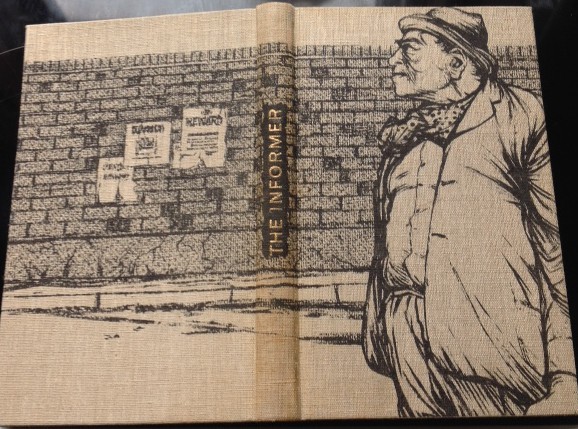Inspiring Older Readers
 posted on 22 Apr 2016
posted on 22 Apr 2016
The Informer by Liam O’Flaherty
Published in 1925 and dealing with Ireland immediately after the declaration of independence, O’Flaherty’s novel is frequently referred to as an example of Irish noir – picking up on the fact that the appearance of this book was contemporaneous with some of the classic US noir fiction of the inter-war years. And it is easy to see why because there are some superficial similarities – the gangster or underworld context, the tough, pithy prose and the moral ambiguity are all there. What O’Flaherty lacks however is the droll wit or sly satire of the great American writers like Hammett, Chandler or Cain.
The plot of the book revolves around Gypo Nolan, ex-policeman and outcast from ‘The Organisation’ which I assume to be a thinly disguised representation of the IRA. Nolan is on his uppers – literally as well as figuratively – because he and his best friend, Francis (Frankie) McPhillip have undertaken an execution of a farmer without the say-so of the Organisation’s hierarchy and so have been cast out of favour. When McPhillip, who actually did the shooting, returns to Dublin Nolan takes the opportunity to turn informer and claim the reward for tipping off the police. In a shoot-out McPhillip is killed, Nolan gets the reward money and almost immediately starts on his own personal journey to hell.
A member of the Organisation’s high command, Dan Gallagher, comes to town to organise the hunt for the informer. Gypo tries, absurdly, to fit up someone else but comes immediately under suspicion. Armed with his £20 - more money than he’s ever had - he begins an odyssey around the less salubrious parts of the city doling out money like there is no tomorrow. Short of running up a flag that says – ‘look at me! I’m the informer’ – he behaves in a way that makes his eventual unmasking and confession inevitable.
What makes this novel so interesting is the ambiguity of the morality that underpins the story and the richness of the characters that populate the book. Gypo is painted as a great elemental force of nature but not a very bright one – he is, despite this, complex and essentially human. Regardless of the fact that he has informed on his best friend we are drawn into a sympathetic relationship with him because we know he’s doomed. Nolan’s sense of his own transgression and his acts of generosity and open spirit – he distributes his money to anyone with a sob-story to tell - are enhanced by the inhumanity of the Organisation and its commanders who are cold, calculating and literally without pity.
The cast of characters is drawn with relish and spring to three-dimensional life off the page. Here is the Dublin underworld, the struggling working class, revolutionary zealots and cold-eyed killers, the weak and the strong. This is a very physical book – it forces you to focus on the tangible and concrete details of everyday life while at the same time running everything through the filter of the moral and ethical self-justification of the central figures.
This is quite a short book – around 200 pages – but it felt much bigger. That’s not a criticism or a suggestion that it somehow dragged – quite the opposite. It romps along but the style takes a bit of getting used to because it’s terse and unadorned. Once you’re committed to the world it creates the book expands to fill the space in your imagination and so feels like a much bigger confection than it is. You’ll be left with a sense of sadness I think – a feeling of grief for everyone in the world of darkness O’Flaherty has created or maybe just exposed.
The copy I read was the Folio edition of 1961 with superb illustrations by Nigel Lambourne that add a real extra dimension to the reading experience. Copies can be purchased on the second hand market for peanuts.
Terry Potter
April 2016